I recently wrote that I’ve been tying and fishing palmered flies for tenkara lately. My theory is that if the hackle is spread out over more of the body of the fly, it will give the pattern more movement and, thus, be more attractive to fish. So I started tying flies with hackle palmered through the thorax (rather than just concentrated at the head of the fly like a sakasa kebari). I was pretty happy with the results. But then I saw this post on the Fly Angler’s Online forum. Someone was asking about using “snatcher” patterns for tenkara. Snatcher? I had never heard of them. But after a little research, it instantly hit me that these patterns would be perfect for tenkara. So, I tried my hand at some…
According to legend, snatcher patterns were invented to fish Loch Leven in Scotland and to imitate the large buzzers (lake midges) there. But I think they’re generic enough to be mistaken for a variety of insects, or just as attractors. And since the hackle is palmered through the entire length of the body, they provide a lot of movement when pulsed (my favorite tenkara presentation). Here are my first few attempts at some common snatcher patterns used in the U.K.
Olive & Gold Snatcher
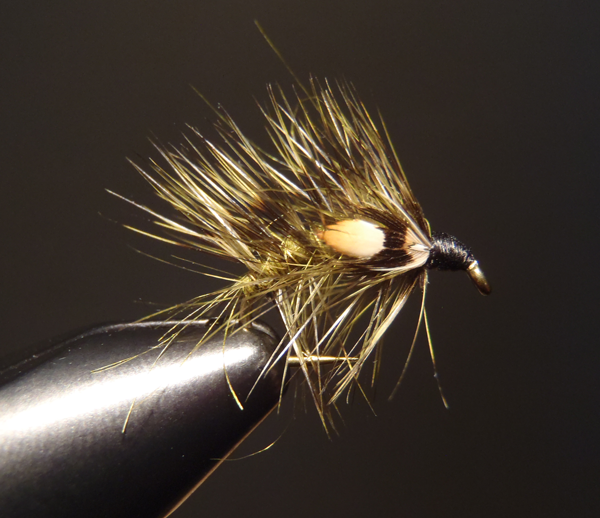
Hook: TMC 2457 #12
Thread: Black
Ribbing: Small gold wire
Body: Olive angora goat dubbing
Hackle: Olive grizzly saddle
Cheeks: Jungle cock eyes
We all know that olive is a great all around color and with it’s dark head, this fly could easily be taked for a swimming caddis when twitched up the water column.
Rabbit Snatcher
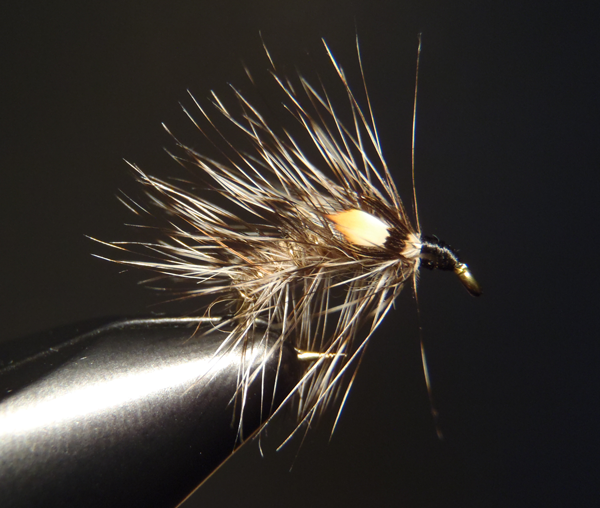
Hook: TMC 2457 #12
Thread: Black
Ribbing: Small gold wire
Body: Natural rabbit dubbing
Hackle: Natural grizzly saddle
Cheeks: Jungle cock eyes
A very generic pattern that looks like everything and nothing at the same time. Basically, a gold ribbed hare’s ear nymph that comes alive under water.
Viva Snatcher
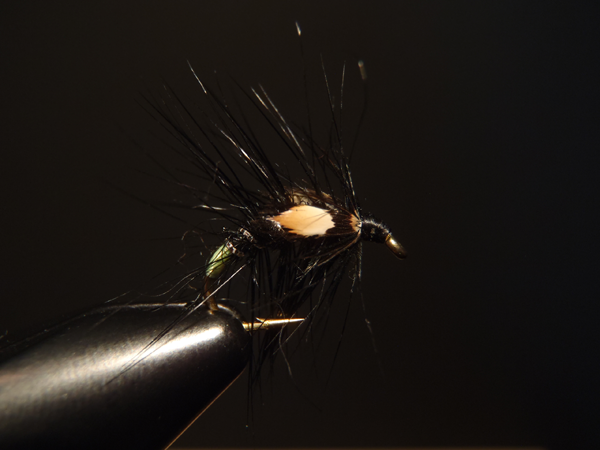
Hook: TMC 2457 #12
Thread: Black
Ribbing: Small oval silver tinsel
Body: Black seal fur (substitute black angora goat dubbing)
Hackle: Black saddle
Cheeks: Jungle cock eyes
Probably every stillwater angler in the U.K. has some variation of the Viva in their box somewhere. It’s a very popular combination of black, sliver, and chartreuse and can take the shape of anything from a thread-bodied midge pupae to a woolly bugger style streamer.
Wickham’s Hot Orange Snatcher
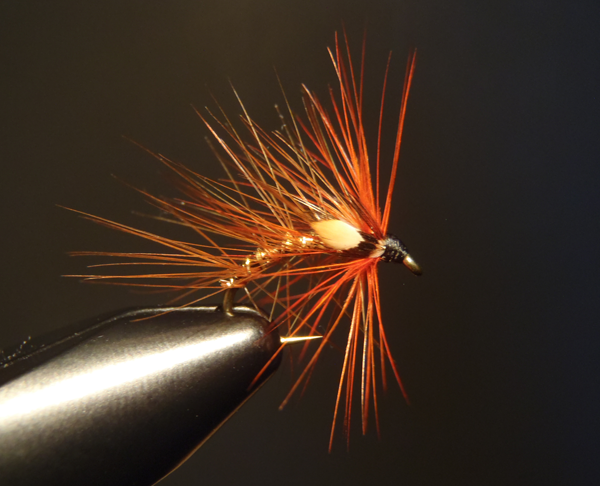
Hook: TMC 2457 #12
Thread: Black
Ribbing: Small oval gold tinsel
Body: medium gold tinsel
Hackle: Brown saddle for the body, hot orange behind the eye
Cheeks: Jungle cock eyes
Another popular stillwater color scheme in the U.K., this one was inspired by the Wingless Wickham’s, which is a variation of the classic Wickham’s Fancy.
Snatcherizing Popular Patterns
While there a a lot of classic snatcher patterns, you can also translate other common patterns into it’s style. For example, here is what a snatcherized Price Nymph might look like:
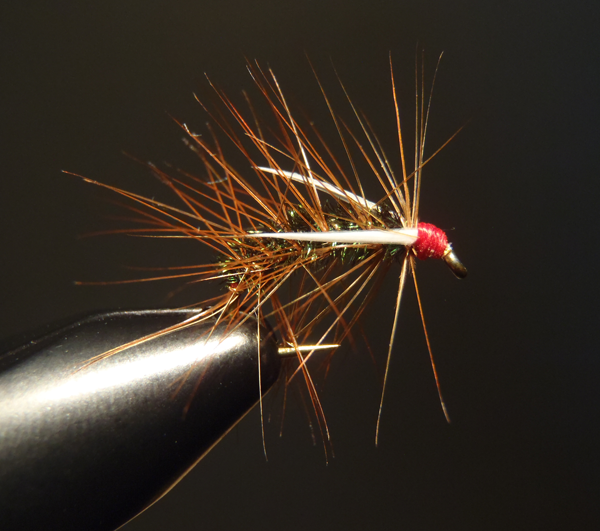
Hook: TMC 2457 #12
Thread: Red
Ribbing: Small gold wire
Body: Peacock herl
Hackle: Brown saddle
Cheeks: White goose biots
How to Tie Snatcher Flies
I tied all of the flies above using the traditional method which is kind of “backwards” of how you might think it is tied. Rather than being tied from the bend and wrapping everything toward the eye, the hackle is actually tied in at the eye, wrapped back, and then ribbing material is wound through the hackle toward the eye to secure it. This isn’t my favorite way of tying (because it looks a little sloppy) but for my foray into snatchery, I thought I’d try to stay true to tradition. Here is a video by Davie McPhail showing the technique:
A Few Notes
- The classic patterns call for jungle cock eyes for the cheeks. Jungle cock isn’t the cheapest bird on the planet and if you have some, you might be reluctant to use it on trout flies. In order to be a bit more economical, some tiers use larger eyes that have been split and just use one half on each size.
- Many snatcher tiers substitute brightly colored goose biots for the cheeks instead of jungle cock. This also gives the fly a unique look.
- When your counter winding the ribbing through the hackle, wiggle it from side to side to avoid trapping hackle fibers.
You can probably see the potential here for experimentation. By switching up the colors, body material, ribbing, and hackle, you could come up with an endless variety of patterns. These are my first experiments with snatchers. But I’m pretty certain they won’t be my last.


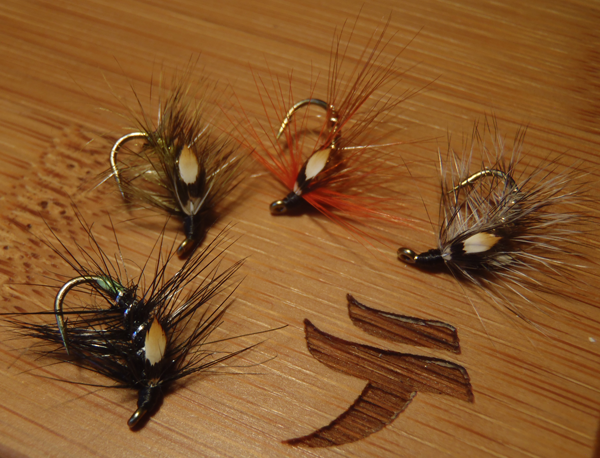






I LIKE! A lot! Looks like a great fly.
Brian
Awesome thanks for the cool ideas Jason.
Dude! Serious tying skills there.
Very cool flies Jason.
Thank you for continuing to show that I’ll never have the skill required to tie flies proffessionally! Good lookin flies(:
Those are very cool flies! Looks like I will be paying a visit to my local fly shop to get some materials this weekend… 😉
… Not like mine will look anything like those though. Lolol 😀
Thanks Jason, I’m Heading to the bench this weekend. No eyes but ill substitute. I really like the idea. I have always tied my Kebaries with more hackle than the norm.
Excellent! I am inspired.
Good looking ties. I have yet to fish the ones I have tied either, but plan to get them wet this week. I used orange goose biots instead of a jungle cock eye for the cheeks.
Gotta love jungle cock eyes. I tried this pattern for the first time this year. http://www.driftlesstroutanglers.com/yaf_postst1806_The-Hornberg-Special-Fly.aspx
I had a pretty good day with it. Better yet, it was developed in the same county I live in and more than likely was fished by its originator on some of the same water I fish.
Dale
Nice flies Jason. They are similar to a wooley bugger tie. I can see how they would be effective.
I have some guinea fowl, and that might work in place of jungle cock for the eyes. They are not as colorful, but it works as a good substitute.
Another great post Jason, thanks for doing what you do.
Brian
sugoi!